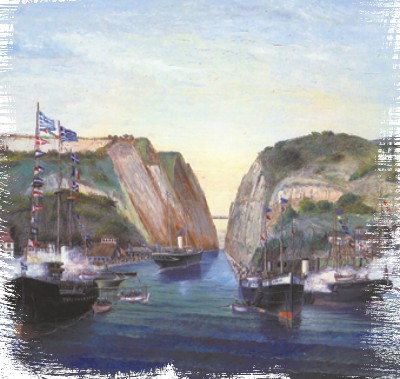

The
Corinth Canal was finally built in the late nineteenth century and created
á new sea route by linking the Corinthian and Saronic Gulfs. Until that
time, ships sailing between the Aegean and the Adriatic had had to
circumnavigate the Peloponnese, adding about 185 nautical miles to their
voyage. However, in antiquity the Greeks had devised á way of solving the
problem of communications between the two seas. In the late seventh or
early sixth century BC, the tyrants of Corinth constructed á paved road
called the Diolkos which led from Schinous on the Saronic Gulf to
Poseidonia on the Gulf of Corinth. The Dioikos was 3-3.5 m. wide, and it
was paved with blocks of limestone set in á deep layer of sand and
gravel. Along this ran the ïlkos, á wheeled vehicle on which ships were
borne overland from one side of the Isthmus to the other.
Sections of the Diolkos can still be seen today; the deep parallel ruts in
the road, 1.50 m. apart, are the marks left by the wheels of the olkos.
had had to
circumnavigate the Peloponnese, adding about 185 nautical miles to their
voyage. However, in antiquity the Greeks had devised á way of solving the
problem of communications between the two seas. In the late seventh or
early sixth century BC, the tyrants of Corinth constructed á paved road
called the Diolkos which led from Schinous on the Saronic Gulf to
Poseidonia on the Gulf of Corinth. The Dioikos was 3-3.5 m. wide, and it
was paved with blocks of limestone set in á deep layer of sand and
gravel. Along this ran the ïlkos, á wheeled vehicle on which ships were
borne overland from one side of the Isthmus to the other.
Sections of the Diolkos can still be seen today; the deep parallel ruts in
the road, 1.50 m. apart, are the marks left by the wheels of the olkos.
The
possibility of digging á canal through the Isthmus had, of course, been
considered by the ancient Greeks. The first to look into the matter was
Periander, tyrant of Corinth, who drew up á plan for á canal in 602 BC.
Subsequent planners included Demetrius Poliorcetes, Julius Caesar and
Caligula. These plans were later adopted by Nero, who in 67 AD announced
to the spectators at the Isthmian Games that he was going to join the two
seas by digging á canal through the Isthmus; indeed, he went so far as to
cut the first turf himself, with á golden pick, and to carry the first
basket of earth on his back. But his plans came to nothing, as did those
of Herodes Atticus, the Byzantines and the Venetians in later times. The
canal we see today was built in 1882-1893 by Greek and French engineers
using the most advanced machinery of the day. General supervision of the
enormous undertaking was in the hands of General
Stepan
Ôûpp, aide-de-camp to the King of Italy. The project was completed by
the Greek Corinth Canal  Company, whose president was Andreas Syngros.
Company, whose president was Andreas Syngros.
The
canal is 6,343 m. in length. It has á width of 24.60 m. at surface level
and 21.30 m. at the sea-bed, and in some places its sides are 79 m. high.
The canal is crossed by road and railway bridges, while communications
between Central Greece and the Peloponnese are also served by two
'ferries' in the form of submersible bridges, one at either end (Poseidonia
and Isthmia).